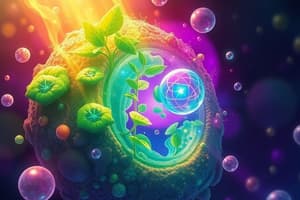Podcast
Questions and Answers
Which process involves the movement of hydrophilic and charged molecules across the membrane with the help of transport proteins?
Which process involves the movement of hydrophilic and charged molecules across the membrane with the help of transport proteins?
- Exocytosis
- Osmosis
- Facilitated diffusion (correct)
- Active transport
What is the main energy source for cells?
What is the main energy source for cells?
- Proteins
- Nucleic acids
- Carbohydrates (correct)
- Lipids
What is the role of enzymes in chemical reactions?
What is the role of enzymes in chemical reactions?
- Slow down the reactions
- Speed up the reactions (correct)
- Have no effect on the reactions
- Prevent the reactions from happening
What is the energy required to start a metabolic reaction called?
What is the energy required to start a metabolic reaction called?
What is the process of converting food energy into a usable form and releasing waste products called?
What is the process of converting food energy into a usable form and releasing waste products called?
Which organelle is responsible for performing specific jobs required by the cell and working with other organelles?
Which organelle is responsible for performing specific jobs required by the cell and working with other organelles?
What is the function of the cytoplasm?
What is the function of the cytoplasm?
What is the main function of the plasma membrane?
What is the main function of the plasma membrane?
Which molecules can cross the plasma membrane?
Which molecules can cross the plasma membrane?
What is the aim for Week 3 in the course Introduction to the Biology of Humans?
What is the aim for Week 3 in the course Introduction to the Biology of Humans?
Which organelle produces energy for the cell through cellular respiration?
Which organelle produces energy for the cell through cellular respiration?
Which of the following is NOT a subcellular structure?
Which of the following is NOT a subcellular structure?
What is the function of the nucleus in eukaryotic cells?
What is the function of the nucleus in eukaryotic cells?
What is the main function of the cell wall in plants, fungi, and bacteria?
What is the main function of the cell wall in plants, fungi, and bacteria?
What is the process of passive transport that involves movement of molecules from an area of high concentration to low concentration?
What is the process of passive transport that involves movement of molecules from an area of high concentration to low concentration?
Which molecule is the high-energy currency of the cell?
Which molecule is the high-energy currency of the cell?
Which process in cellular respiration requires oxygen?
Which process in cellular respiration requires oxygen?
Where does glycolysis occur?
Where does glycolysis occur?
What is the overall reaction of aerobic cellular respiration?
What is the overall reaction of aerobic cellular respiration?
Which stage of cellular respiration produces the most ATP?
Which stage of cellular respiration produces the most ATP?
Which metabolic process can generate energy without oxygen?
Which metabolic process can generate energy without oxygen?
Which of the following is NOT a product of fermentation?
Which of the following is NOT a product of fermentation?
What is the difference between a benign tumor and a malignant tumor?
What is the difference between a benign tumor and a malignant tumor?
How do cancer cells differ from normal cells?
How do cancer cells differ from normal cells?
What are some risk factors for developing cancer?
What are some risk factors for developing cancer?
Which of the following statements about alcohol and cancer risk reduction is true?
Which of the following statements about alcohol and cancer risk reduction is true?
What is the recommended daily intake of alcoholic drinks for women to reduce cancer risk?
What is the recommended daily intake of alcoholic drinks for women to reduce cancer risk?
Which of the following is NOT a risk-reducing behavior for cancer prevention?
Which of the following is NOT a risk-reducing behavior for cancer prevention?
What is the biological mechanism behind the risk reduction associated with eating a low-fat, high-fiber diet?
What is the biological mechanism behind the risk reduction associated with eating a low-fat, high-fiber diet?
Why is maintaining a healthy weight important for reducing the risk of certain cancers?
Why is maintaining a healthy weight important for reducing the risk of certain cancers?
Flashcards are hidden until you start studying
Study Notes
Transport Processes in Cells
- Movement of hydrophilic and charged molecules across membranes occurs through facilitated diffusion, involving transport proteins.
- Passive transport relies on concentration gradients, moving substances from high to low concentration.
Energy and Metabolism
- The primary energy source for cells is adenosine triphosphate (ATP), known as the high-energy currency of the cell.
- Energy required to initiate a metabolic reaction is called activation energy.
Enzymes and Chemical Reactions
- Enzymes act as catalysts in biochemical reactions, speeding up processes by lowering activation energy barriers.
Cellular Processes
- The conversion of food energy into usable forms, while releasing waste products, is termed cellular respiration.
- Glycolysis, the first step of cellular respiration, occurs in the cytoplasm.
Organelles and Their Functions
- Organelles perform specific functions within cells, collaborating to sustain cellular activities.
- Mitochondria are responsible for energy production through cellular respiration.
- The nucleus stores genetic material and regulates cellular activities in eukaryotic cells.
Plasma Membrane and Cytoplasm
- The plasma membrane's main function is to regulate the entry and exit of substances in and out of the cell.
- Cytoplasm serves as a medium for biochemical reactions and houses organelles.
Cancer Biology
- Benign tumors are non-cancerous and do not invade surrounding tissues, while malignant tumors are cancerous and can spread.
- Cancer cells often exhibit uncontrolled growth and can differ from normal cells in function and adherence to death signals.
- Risk factors for developing cancer include genetics, lifestyle choices, and environmental exposures.
Alcohol and Cancer Risk
- Reducing alcohol intake can lower cancer risk; recommended daily intake should be limited for women to maintain health.
Nutrition and Cancer Prevention
- A low-fat, high-fiber diet may reduce cancer risk by improving metabolic health and reducing obesity-related risks.
- Maintaining a healthy weight is crucial for minimizing the risk of certain cancers, as excess body weight is a significant factor.
Additional Insights
- Aerobic cellular respiration requires oxygen and is the most efficient ATP-producing pathway.
- The stage of cellular respiration that yields the highest ATP concentrations occurs during oxidative phosphorylation.
- Anaerobic processes like fermentation can provide energy in low-oxygen environments, although different products may result.
Studying That Suits You
Use AI to generate personalized quizzes and flashcards to suit your learning preferences.




